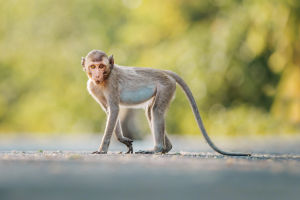Have you ever wondered what it’s like to live like a macaque? Today, let's dive into their vivid and incredible lives together!
We promise, you’re about to see them in a brand-new light.
What Do Macaques Look Like?
We find that macaques are among the most common monkeys in nature. Their body length is about 47–64 cm, and their tails range from 19–30 cm. Males usually weigh around 7.7 kg, while females are lighter at about 5.4 kg. Compared to their cousins, macaques are slightly smaller and have slimmer faces without whorls of hair on their heads.
Their fur mostly shines in gray-yellow or gray-brown tones. The back shows a brownish-gray hue, while the lower body glows with orange-yellow or even orange-red colors. Their faces and ears are usually flesh-colored, and their hip pads are large and pinkish-red. Males, notably, are bigger than females.
The Special Structure of Their Bodies
Macaques have a protruding snout, strong jaws, and 32 teeth ready for chewing. Their nostrils point downward and are closely set, allowing their eyes to face forward, giving them excellent 3D vision—perfect for navigating forests. Their sense of smell, however, isn’t as strong. Each of their hands and feet has five fingers or toes, tipped with flat nails, helping them firmly grip branches. Plus, they have food pouches in their cheeks, allowing them to store snacks on the go.
Where Do Macaques Live?
We’ll discover that macaques aren’t picky about where they settle down. From low hills to high altitudes of 3,000–4,000 meters, they can thrive in tropical, subtropical, and even warm temperate forests. They especially love rocky, cliff-filled areas intertwined with streams and lush greenery. As long as food and shelter are available, they are happy campers.
How Macaques Spend Their Days?
Macaques live in big, lively groups led by a dominant leader—what we often call the "monkey king." Their daily lives are filled with climbing, exploring, and socializing. We’ll see that when the group moves, there’s always a "sentry" stationed at a high point. If any danger appears, this lookout immediately signals everyone to escape. Thanks to their superb climbing and jumping skills, they vanish in a flash! Their group size varies depending on food availability, sometimes just a dozen and sometimes over a hundred.
The Fascinating Eating Habits of Macaques
Macaques are big fans of leaves, tender branches, wild vegetables, and fruits. But they don’t stop there—small birds, eggs, insects, and even worms and ants are on their menu. They can be greedy when it comes to sweet ripe fruits, often grabbing and tossing aside unripe ones, leaving a trail of discarded branches and fruits behind. Because of this, their search for food takes them on long journeys every day.
How Does a Monkey Become the King?
One of the most exciting parts of macaque society is the battle for leadership. Every four years, just like a "presidential election," the monkey king must defend his throne. When his term nears the end, ambitious males challenge him by raising their tails high—a bold symbol of defiance. Fierce battles follow.
Only after defeating the reigning king and all other challengers can a new leader rise. The fights are brutal, often leaving the losers with injuries. The fallen king is usually cast out, left to wander alone.
The Perks of Being a Monkey King
Winning the throne comes with serious perks! The king eats first, enjoys the best spots, and holds a powerful position over the group. He also enjoys a privileged "harem," with many female companions. Life as a monkey king is good—but keeping that crown means constant vigilance against rivals.
Macaque Families and New Life
During breeding seasons or times when food is scarce, macaques gather in even larger groups. Female macaques, after a five-month pregnancy, usually give birth near streams. It’s not uncommon to see them bathing their newborns in clear mountain waters. Their love and care for the young mirror the tenderness we see in many families around the world.
What Makes Macaques Special?
Beyond their structure and social life, macaques surprise us with their human-like expressions. They can swim, imitate human actions, and show emotions like happiness, anger, and sadness. When irritated, some macaques have even been seen tossing stones at intruders—a true sign of their spirited personalities!
Lykkers, aren’t macaques simply amazing? Their tight-knit communities, playful spirits, and brave leadership battles show us a fascinating world that’s not so different from ours. Next time we explore nature, let's keep our eyes open—you never know when we might spot these clever climbers in action!
Would you want to live a day as a macaque? Tell us! We’d love to hear your wildest macaque adventure ideas!
Macaque Monkeys at War | BBC Earth
Video by BBC Earth


